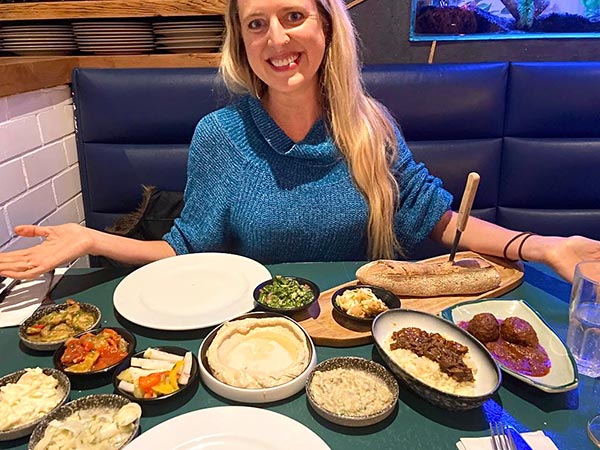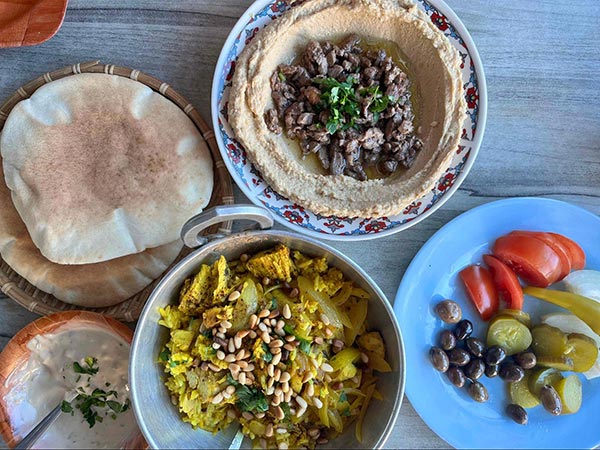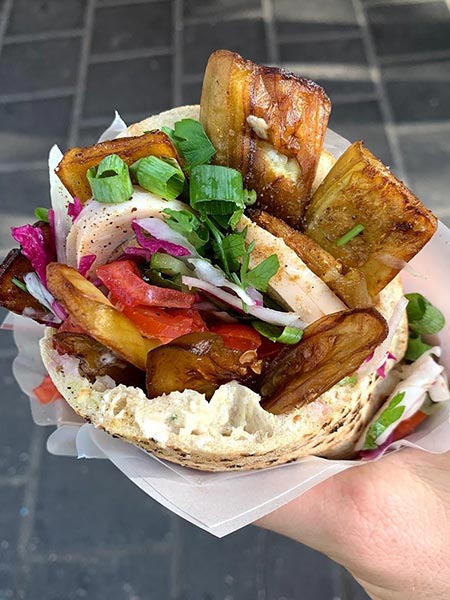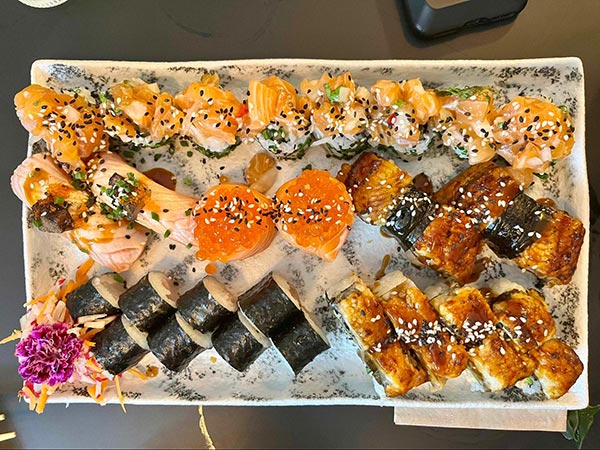Sophie Lippert, concert pianist and All Classical Portland’s International Arts Correspondent, is currently living in Tel Aviv, Israel. In this edition of Musician Abroad, she takes us on a journey through Tel Aviv’s live music scene.
Moving from Portland to Tel Aviv has been an incredible experience. I’ve immersed myself in Israeli society—seeking out sights and sounds, flavors and tastes, places and spaces that have helped me engage with local culture and community.
One of the things that’s been most rewarding has been harnessing my background as a pianist and cellist to forge connections, make new friends, and expand my sensory horizons.
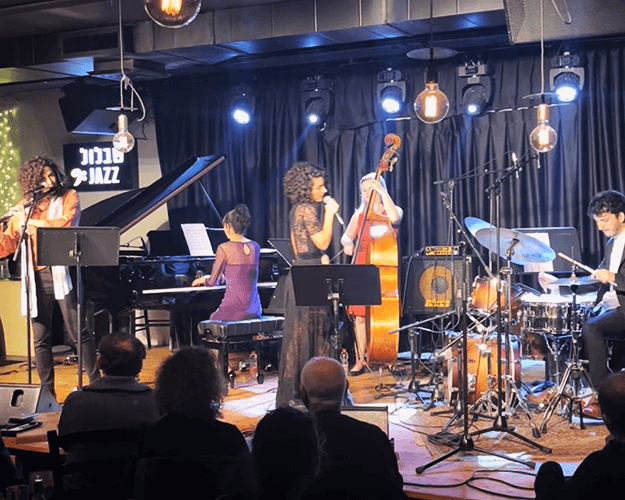
Over the year I’ve been in Tel Aviv, I’ve been lucky enough to pursue several different paths of musical exploration:
- Learning, recording, and performing music written by Israeli female composers,
- Playing at several events in Israel, and collaborating with fabulous area musicians,
- Attending a unique array of concerts, and reveling in the local live music scene.
In my last blog post as All Classical Portland’s International Arts Correspondent, I’m excited to paint a colorful picture of my recent musical high points, focusing on the three areas above.
1. Learning Music by Israeli Female Composers
Let’s rewind for a moment to March 2020, when the COVID-19 pandemic first began affecting Portland and my world. My performing career was temporarily suspended, and I was forced to cancel all upcoming shows in my concert series, Connections Concerts. I knew I needed to pivot my focus away from collaborative music, and toward solo projects for the foreseeable future. At that time, I took on two big musical projects: recording my first solo piano album, Time Travel, and revamping my repertoire while devoting myself to learning music written by female composers.
It turns out that I quite like playing music written by women and feel especially passionate about sharing music that’s not already in the common classical music vernacular. There are SO many great pieces that have rarely (if ever!) been performed and recorded. I find it a tremendous honor—and hugely exciting—to bring these underexposed composers and pieces to the ears of new listeners.
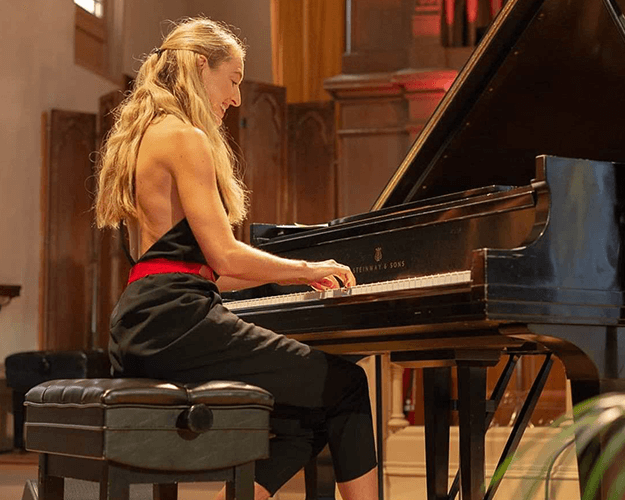
Now, let’s fast-forward to late 2021. Upon arriving in Tel Aviv, jetlagged and navigating serious culture shock, I began to research Israeli female composers. I didn’t know exactly what might manifest with these new pieces, but I DID know it felt like an important and powerful way to forge connections with Israeli culture, and the local music scene.
I threw myself into the process, digging deep into the archives at the Israeli Music Library, contacting individual composers whose music intrigued me, and requesting score samples. Eventually, I ended up purchasing over 50 pages worth of sheet music, all written by Israeli women over the course of the last 50 years. And then, the fun really started: learning this magnificent music!
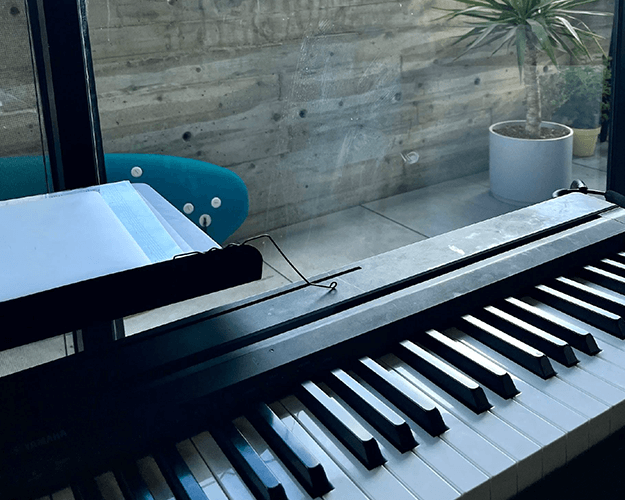
From start to culmination, it’s been an utter joy. I’ve been in contact with two of the composers whose music I’ve learned, Na’ama Tamir Kaplan and Lotti Amit-Kalev, and it’s been great to correspond and exchange support and camaraderie. The learning process itself has been rich and rewarding, playing repertoire that’s never previously been recorded means I have the opportunity to develop a truly personal relationship with the music. I’m freed from referencing other interpretations, or feeling like I have to “match up” to tempos, phrasings, or other artistic decisions made by other pianists. Talk about freeing—and a bit intimidating, too!
I also deeply appreciate how much this Israeli music feels firmly of this place. Though each of the composers whose libraries I’ve explored have different ways of manifesting the cultural ethos here, I find them all beautifully representative of the complexity, color, vibrancy, and perpetual dance of contrasts that I experience in Israeli people and places. There is abrasiveness and intensity, alongside hearts of gold; an embrace of individualism, along with an orientation toward community and family. The music I’ve learned this year reflects all that, and more: it leans in to tension, and celebrates resolution; it doesn’t shy away from challenging dissonance and chord structures, while also finding places to release into blissful harmonic terrain.
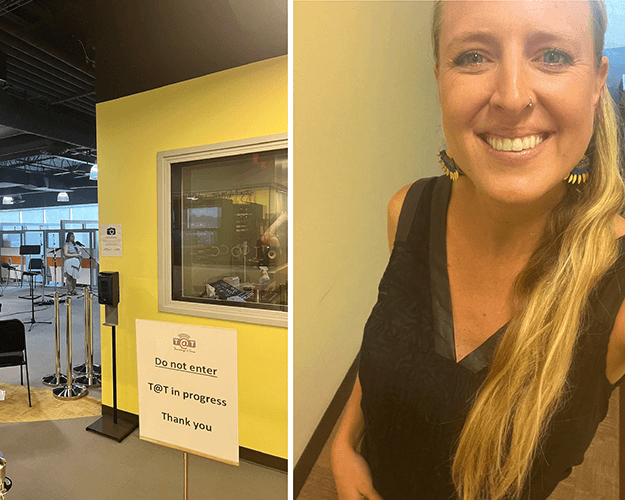
Thursdays at Three program.
When I traveled back to Portland this summer, I had the tremendous joy of performing a handful of my favorite Israeli pieces on All Classical Portland’s Thursdays at Three, hosted by Christa Wessel! During the month of October, I rented a beautiful Steinway at the Ra’anana Music Center, hired a stellar audio engineer, and recorded 22 minutes worth of repertoire by three different composers: Na’ama Tamir Kaplan, Lotti Amit-Kalev, and Sarah Feigin. I’m proud to share that the culmination of those efforts is a brand new EP titled Seaside, which is now available on Spotify, Apple Music, and other streaming platforms!
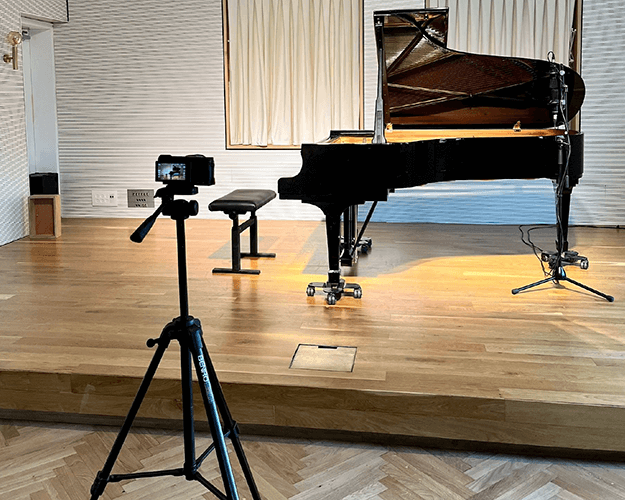
Learning this fantastic music by Israeli women was a highlight of my year; sharing it with a new audience is an even greater honor and joy.
2. Playing Music in Tel Aviv
During my time in Tel Aviv, my career as a professional pianist has been decidedly humble. I’ve performed in intimate venues and settings, rather than on big stages; my endeavors have been as a solo or small-group musician, rather than as a performer with an orchestra or a larger group of collaborators.
But there’s been no lack of richness. I’ve loved having the opportunity to perform in a slew of different settings. And, each time I’ve played live this past year, there’s been a guiding force: the desire to use my music to connect with individuals, families, or local communities.
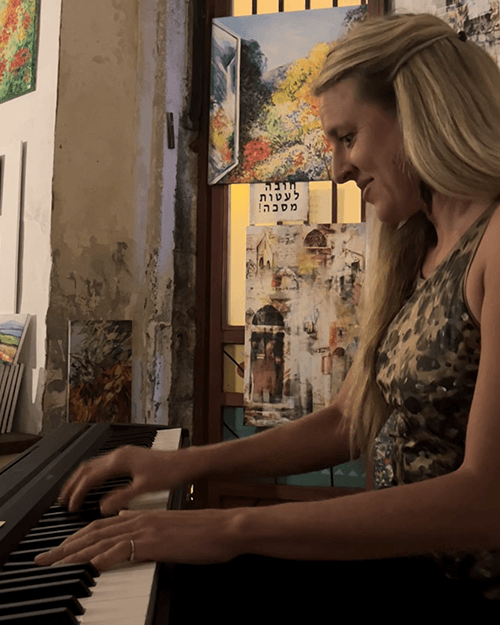
I performed at a pop-up “Secret Dinner Party.” Local entrepreneur Charlotte Rehov stands at the helm of this brilliant endeavor. She finds different unusual venues around town, and invites small groups of people to eat an amazing 4-course meal, drink delicious wine, meet new friends, and hear music by a live musician. The evening I came and serenaded her attendees, the dinner took place at a wild and whimsical local gallery, which was covered floor-to-ceiling with bright art prints. I delighted in providing acoustic ambiance to the evening, and spoke to the group about the power of connection through music. What a treat!
I performed at a birthday party. A serendipitous conversation with a new friend led me to land this gig in central Israel, where a family of 20+ lively Israelis gathered to celebrate their matriarch’s 60th birthday. The family knew of her deep love for the cello, and so they hired me to play a small concert to kick off their festivities. The whole evening was absolutely memorable—especially when the matriarch was blindfolded, paraded in, seated directly in front of me, and then invited to take off her blindfold when I started playing a selection from Bach’s G Major Suite for Solo Cello. She was overcome with emotion for the entirety of my 40-minute set, and the group whooped and hollered with appreciation each time I finished a song. As an encore, I ended up taking a number of requests, and the whole room sang along with their favorite songs from musicals and pop culture. Again: what an opportunity to deepen in connection! I emerged with cherished memories.
I collaborated with a new friend, in support of an EP release of her original compositions. This was a particularly special experience for me, as it afforded me the chance to expand my musical horizons in several noteworthy ways:
- My classical music training has led me to hold myself to a very high standard of playing; I rarely give myself space to free myself from perfectionism, and be unencumbered by expectations for “how things should sound.” Here, I was encouraged to be as messy and imperfect as possible, and it allowed me to create in a vastly different way than I usually do. My intuitive, improvisatory side was given a chance to soar!
- I’m used to recording being a very formal and technical experience: working with high-caliber engineers in established recording studios, working out take after take with impeccably-tuned acoustics. Here, we were recording in the living room of an open-air home in Pardes Hanna—an Israeli city known for its support of alternative lifestyles and connection to nature—with an engineer who offered us fresh lychee fruits from his yard in between takes. Yes, please!
- As a performing pianist, I often find myself “front and center”; asked to carry a full piece—or a full concert!—myself. Here, as a “back-up musician,” I had the privilege of playing a supporting role to someone else’s brilliance—and boy, was it a treat. I love using my instrument to weave a particular musical texture into a mix; to create one layer of many, that complements and enhances a musical vision.
I collaborated with a local violinist, and learned some gorgeous new duets! In late Spring, after a few months of settling in to my new Israeli life, I began itching to make music in a more traditional chamber music setting. Shyly, I posted in one of Tel Aviv’s most popular Facebook groups—introducing myself and putting out a call for musicians—and I received over 100 responses! A number of collaborative relationships emerged, including one with a fantastic local violinist, Eva, who shares both my musical ethos (an orientation toward inclusivity, innovation, connection, and eschewing convention in favor of fun!), and my passion for female composers. We had a blast sight-reading through a book filled with fantastic music written by women, and then settled on four pieces to really dig in with: music by Clara Schumann, Lili Boulanger, and Dora Pejacevic. The culmination of our efforts? A “Salon-style” performance, which we video recorded in my living room—featuring the looming skyline of Tel Aviv in the background. Forging this connection was a delight; Eva and I instantly meshed (both as players, and humans!), and our musical communication felt effortless. And in my book, there’s nothing better than playing great repertoire with a performer who listens keenly, is deeply expressive and responsive, and genuinely loves the process. Pure joy!
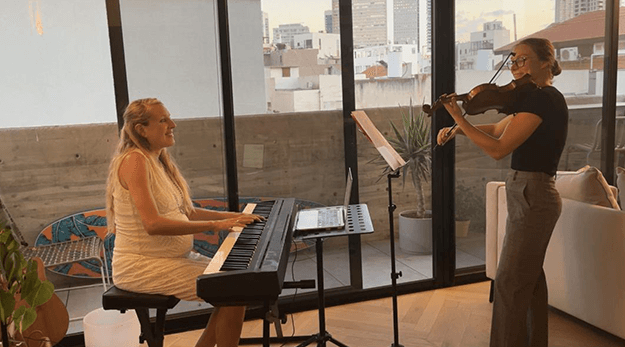
3. Concerts and Live Music in Tel Aviv
The live music scene in Israel is vibrant, lively, eclectic, and community-oriented. Electronic clubs feature DJs every night (and all night!); pop bands draw large, raucous, dedicated crowds; folk and religious music plays a part in every national holiday, all of which are drawn from the Jewish calendar. There are several areas I’d like to shine a spotlight on:
Classical Music: The local classical music scene consists of well-established and high-caliber ensembles and musicians. The two largest established organizations are the Israeli Philharmonic Orchestra and the Israeli Opera, both of which are based in Tel Aviv; there are also several excellent early music groups, modern classical ensembles, and both traditional and innovative chamber music festivals and subscription-based series. A local and personal favorite is Orit Wolf’s On A Personal Note, which is housed at the stunning Tel Aviv Art Museum and features Wolf in collaboration with a fabulously diverse array of musicians. At one concert I attended, Wolf showcased a fiery and irresistible percussion ensemble, played a version of Bach’s Prelude in C accompanied by a handpan drum, and even got the whole audience clapping along to an unusual ⅞ time signature! Wolf narrates each themed concert with warm and welcoming dialogue, sitting with her guest musicians and conducting quasi-interviews during and after songs.
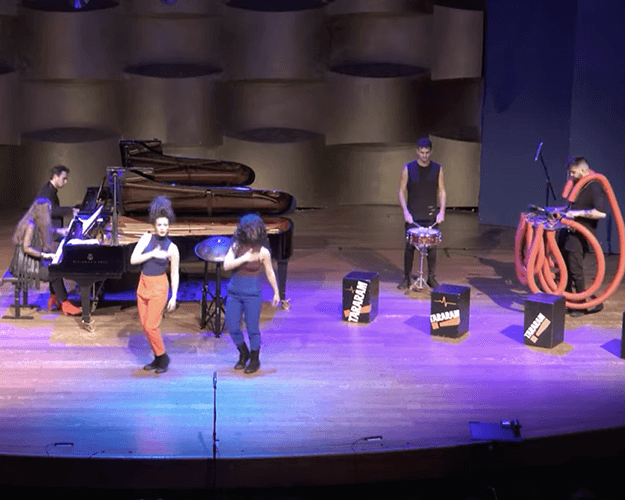
Jazz music: The jazz music scene in Tel Aviv is robust, variable, and vitalizing. There are medium-sized jazz clubs that feature touring acts and more “mainstream” sound; Shablul Jazz, for example, is a dinner and drinks venue that feels like it could be equally at home in London or Nashville! There are smaller clubs, like the beloved Beit Ha’amudim, that feature exclusively local acts and a strong emphasis on inventive, improvisatory, convention-eschewing, boundary-pushing “free jazz.”
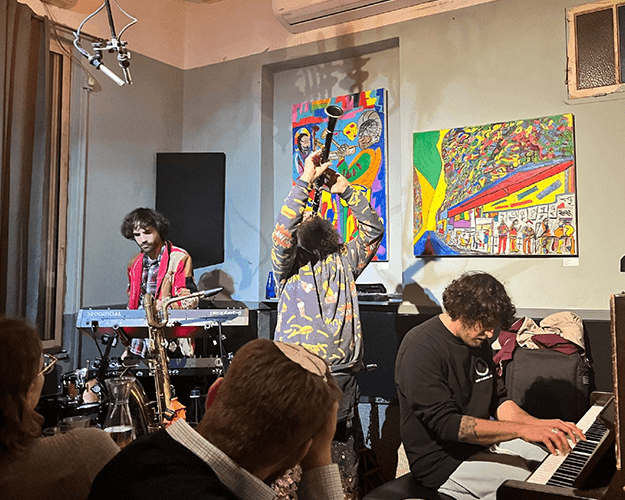
And then, there are the surprise outliers. The most memorable musical experience I had this year took place at a hidden gem of a venue, the Yung Yiddish Library, housed in Tel Aviv’s cavernous and mazelike bus station. Finding the venue was adventure enough (I wove through many a dark and winding hallway before discovering an unassuming door with a vaguely recognizable sound of clarinet wafting out); upon entering, I found myself in a space featuring well-worn Persian rugs, a strange assortment of mismatched furniture, a crowded and chaotic stage area (featuring, among other things, a huge Merry-Go-Round horse), and floor-to-ceiling bookshelves filled with Yiddish books. The first concert I attended was more of a klezmer music workshop—so, after a short performance featuring a pianist, percussionist, clarinet player, attendees were invited to sing or play along for a few hours more of music. To pair with the music? Homemade local sweet treats and shots of hard liquor, or course! A few months later, I was lucky enough to catch Israeli’s beloved Nigun Quartet at Yung Yidish; this stellar jazz group generally plays at larger venues, so seeing them in such an intimate setting was a rare treat. Nigun Quartet is one of Israel’s best representations of a marriage of solid modern jazz in marriage with musical tropes influenced by klezmer music; their original compositions all weave in traditional Israeli sounds and melodies, and their leader—a tall, charismatic clarinet player—can really rip!

Street music: The street music scene is another vital and exciting part of the Israeli musical environment. On evenings and weekends, the busy Tel Aviv promenade is filled with local street performers; they sometimes collect modest crowds, and other times merely attract the attention of passerby’s who pause and listen for a few moments before continuing their beachside walks or runs. Since I walk the promenade nearly every day, I’ve come to recognize a handful of the most regular players: the handpan drum player, who accompanies himself with a boxy cajon drum, and uses looping to enhance and expand his sound; a peppy 20something colloquially known as “The Sunflower Girl” (due to the vase of sunflowers she always places next to her when she plays), with a killer voice and an uncanny ability to “shred” on her electric guitar; a saxophone player, who rips and roars over background jazz tracks that he broadcasts through an accompanying loudspeaker; a guitar duo who play American rock classics, weaving in beautiful instrumental and vocal harmonies. And on Saturday mornings, a quartet of four endearing old chaps play schmaltzy classical “greatest hits” without amplification of any type—in accordance with traditional rules of not using technology on the Sabbath.
Along with regular fixtures, live music abounds on weekends and local holidays, and there have been many occasions in which I’ve stumbled unexpectedly upon a show in neighborhood parks and cafes. The fact that the weather is generally sunny and hospitable all year round certainly helps cultivate a vibrant, ongoing street music scene.

of Tel Aviv.
To Close: Reflection, and Gratitude
Even before moving from Portland to Tel Aviv, I knew I had a strong desire to connect with Israeli culture through the avenue I love most: music! I’m so pleased that I’ve found so many fantastic, fruitful opportunities for exploration.
By learning music written by Israeli women, performing live at a slew of memorable events, and attending live concerts with local musicians, both my musical and connective cups have been filled way up.
On a personal note: I’ve also deeply appreciated the opportunity to connect with YOU, the All Classical Portland community. From sharing a program of Israeli music on Thursdays at Three in July, to taking over the station’s social media channels, to sharing pictures and stories on the Arts Blog, it’s been an immense joy to travel with you this year. I can’t thank you enough for joining me on my Tel Aviv adventures, and I can’t wait to share music and words with you again—from wherever that may be!
Until the next time: many well-wishes from the shores of the Mediterranean Sea.
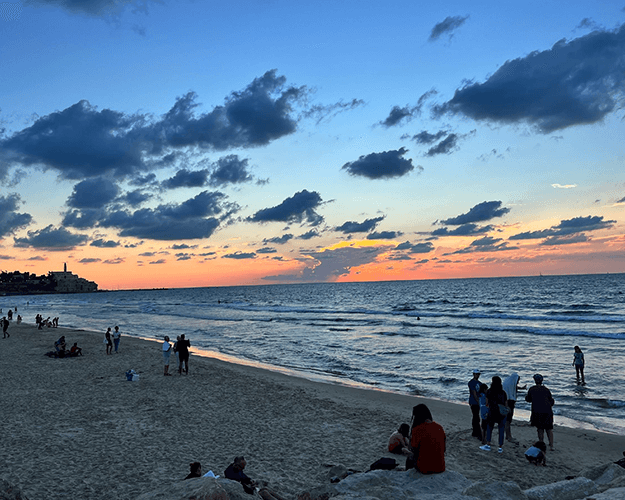
Learn more about Sophie at sophielippert.com.














